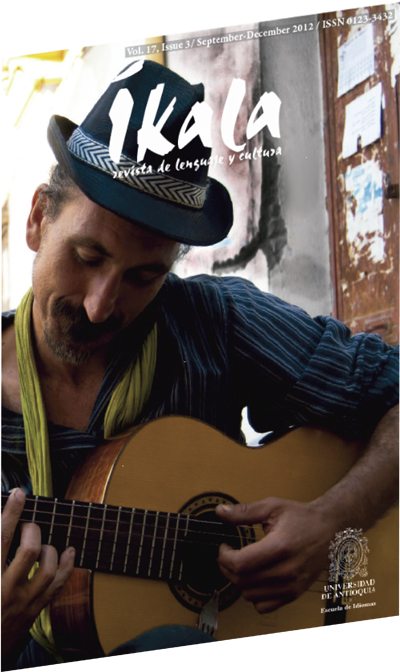Smart_PV: Uma aplicação de software para a gestão de verbos frasais em inglês
DOI:
https://doi.org/10.17533/udea.ikala.11639Palavras-chave:
verbos frasais, verbos adverbiais, verbos preposicionais, mobilidade da partícula, mineração de textosResumo
Os verbos frasais (VF) são unidades léxicas conformadas por um verbo e uma ou duas partículas. Este artigo apresenta uma caracterização para os VF em inglês, usada como eixo principal de um aplicativo web para VF chamado Smart_PV. O objetivo de Smart_PV é duplo: i) permitir o ingresso de VF y ii) detectar VF em textos. Foram criadas duas interfases web para inserir os VF com suas características e para detectá-los em textos assim: o usuário insere um texto e começa o processo de detecção de VF dividindo o texto em palavras. Smart_PV foi validada inserindo 80 VF (incluindo os 25 VF mais comuns em documentos da União Europeia), detectando VF em textos de diferentes domínios. Os resultados mostram a conveniência desse tipo de aplicativos para professores, estudantes, tradutores e usuários comuns como apoio em tarefas de tradução e mineração de textos. Embora seja desejável uma base de dados com mais VF e a análise de mais documentos, os resultados obtidos demonstram a viabilidade e a utilidade do aplicativo.
Downloads
Referências
Álvarez, G. (1990). ¡Partículas, partículas, partículas!: aproximación pedagógica a los verbos adverbiales y los verbos preposicionales ingleses. Cauce Revista de Filología y su didáctica, 5(13), 239-249.
Baldwin, T. (2005). Deep lexical acquisition of verb- particle constructions. Computer Speech and Language, 19(1), 398–414.
Capelle, B., Shtyrov, Y., & Pulvermuller, F. (2010). Heating up or cooling up the brain? MEG evidence that phrasal verbs are lexical units. Brain and Language, 115(3), 189-201.
CartoWeb (2010). CartoWeb documentation. Retrieved from http://www.cartoweb.org/doc/cw3.3/xhtml/user.tooltips.html.
Claridge, C. (2000). Multi-word verbs in early Modern English. A corpus-based study. (Language and Computers 32). Atlanta, GA: Rodopi Bv Editions.
Colin, B. (2005). Learning about the meaning of verb– particle constructions from corpora. Computer Speech and Language, 19(1), 467–478.
Gries, T. (2001). A multifactorial analysis of syntactic variation: particle movement revisited. Journal of Quantitative Linguistics, 8(1), 33-50.
Hart, C. (1999). The ultimate phrasal verb book. Hauppauge, NY: Barron's Educational Series. Retrieved from: http://books.google.com.co/books?id=1XixeA7xHrcCprintsec=frontcoverhl=essource=gbs_ge_summary_rcad=0#v=one pageqf=false
Hill, S., & Bradford, W. (2000). Bilingual grammar of English-Spanish syntax: a manual with exercises and key. Maryland, MD: University Press of America.
Hoque, M. (2008). An empirical framework for translating of phrasal verbs of English sentence into Bangla. CUET Journal, 2(8), 43-49.
Indranil, S., Ananthakrishnan, R., & Sasikumar, M. (2004). Example-based technique for disambiguating phrasal verbs in English to Hindi translation. Mumbai, India: CDAC Mumbai.
Kendris, T. (2008). Complete English grammar review for Spanish speakers. New York, NY: Barron's Educational Series.
Lavin, E., & Sánchez, F. (1989). Diccionario de verbos ingleses con partícula. Madrid, Spain: French & European Pubs.
McArthur, T. (1992). The Oxford companion to the English language. New York, NY: Oxford University Press.
Sankar, K., David, W., & Kalyan, M. (2007). Case- based reasoning in knowledge discovery and data mining. Washington, DC: John Wiley & Sons.
Scott, B., & Neil, T. (2009). Designing web interfaces: Principles and patterns for rich interactions. New York, NY: O'Reilly Media.
Staab, S., & Studer, R. (2009). Handbook on ontologies. International handbooks on information systems. Berlin, Germany: Springer.
Trebits, A. (2009). The most frequent phrasal verbs in English language EU documents – A corpus- based analysis and its implications. SYSTEM, 30(37), 470-548.
Downloads
Publicado
Como Citar
Edição
Seção
Licença
Copyright (c) 2012 Íkala, Revista de Lenguaje y Cultura

Este trabalho está licenciado sob uma licença Creative Commons Attribution-NonCommercial-ShareAlike 4.0 International License.












